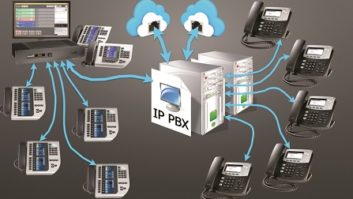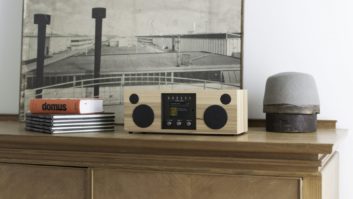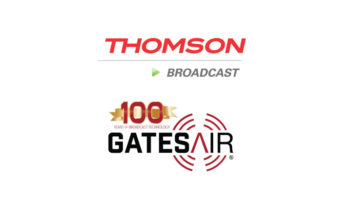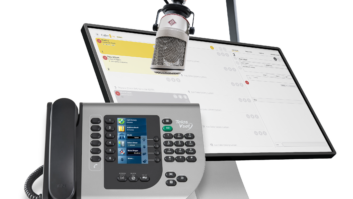OTTAWA, Ontario — Once seen as an esoteric alternative to traditional telephone equipment, voice over IP (VoIP) telephone systems are proving reliable, cost-effective and flexible communications platforms for radio broadcasters.
Broadcasters such as the BBC, Czech national radio Český rozhlas, and the Australian Radio Network are currently using the Broadcast Bionics PhoneBOX VoIP product, which is just one major provider of VoIP technology in the radio broadcast market
HOW IT WORKS
In its simplest terms, VoIP refers to the encoding of voice audio into digital packets. These packets are then transmitted like any form of data across an IP network, rather than over conventional switched telephone lines.
The Architecture of Comrex’s STAC-VIP VoIP Broadcast Platform.
Courtesy: Comrex

Click on the Image to Enlarge
“VoIP basically replaces the PSTN/POTS network we’ve been using for over 100 years,” said Chris Crump, Comrex’s senior director of sales and marketing. Comrex makes the STAC-VIP VoIP telephone system for radio.
“The difference is that your VoIP telephone appliance would plug into your Internet service provider, rather than conventional telephone lines. The VoIP lines are much more easily integrated into enterprise in-house PBX phone systems these days. In fact, it’s nearly impossible to find a new analog POTS-based PBX anymore … not to mention that many telcos have already internally converted their voice networks to VoIP.”
By converting voice into data, VoIP allows telephone users to enjoy all of the advantages of IP transmission. They include a worldwide reach at much lower carriage rates than long distance telephony; even free if carried over the public Internet. Audio frequencies are not as massively compressed (50 Hz–3.5 kHz) over VoIP as they are with conventional switched networks, resulting in far better audio quality. Moreover, since VoIP systems are software-driven — rather than the mechanical hardware systems that define telephone switched-circuits — they are far easier to upgrade and integrate with a radio station’s internal LAN.
BENEFITS FOR RADIO
Telephones are vital tools for radio broadcasters; whether for taking calls from listeners, chasing down sales for advertising or linking live to reporters and talent outside the studio. Radio-oriented VoIP systems are designed to do all of these functions, just like a conventional private branch exchange switched-circuit system would. The big plus is that they can do the job for much less than traditional switched-circuit phone lines.
“A typical telephone line costs US$30 to US$70 a month, plus long distance,” Crump said. “A VoIP line, which your VoIP provider links to the regular telephone network, could cost as little as US$10 per line. Most come with long distance thrown in, simply because it doesn’t cost the VoIP provider extra to link data calls over long distances.”
As high tech as VoIP is in comparison to POTS lines, it is becoming the de facto standard for new connections made by established telephone companies. Eventually the time will come when VoIP will be the only way to get telephone service, as the world settles on IP-based telecommunications.
“When we opened an office in Riga, Latvia, four to five years ago, we had no choice but to use VoIP,” said Kirk Harnack, vice president of Telos Systems. “In Europe, the scarcity of switched system lines means that carriers are eager to phase out POTS and ISDN in favor of VoIP, whose capacity isn’t dictated by actual physical phone lines.”
As mentioned earlier, VoIP provides radio stations with much better telephone audio quality. “For one thing, we can eliminate all of the scratchiness and other audio problems associated with POTS audio,” Harnack said.
“For another, today’s smartphones have much better microphones,” Crump added. “This means that their calls have much broader frequency response, resulting in far more listenable audio during radio call-in shows, listener requests, and news reports.”
But that’s the beginning. VoIP telephone systems for radio can provide broadcasters with exceptional functionality.

Broadcast Bionics’ PhoneBOX as seen from the DJ’s perspective. Courtesy: Broadcast Bionics A case in point: “Broadcast Bionics’s PhoneBOX VoIP platform lets DJs queue VoIP telephone messages with Tweets, Facebook posts and Google+ messages, SMS, and emails into a complete interactive queue list,” said Kirsten Smith, Broadcast Bionics’ business development manager.
“But it’s more than a simple list: Broadcast Bionics has created filters, searches and smart queues based on the tracks playing on air using “now” and “next” information from the playout system, plus location-based searches using post/ZIP codes or coordinates. Incoming messages can be pushed elsewhere within the station, for use with the news, weather or traffic teams, or even to management or direct to your website with one click of a button.”
Put it all together and VoIP systems for radio provide lower operating costs, better audio quality and highly flexible call management capabilities.
THREE VOIP OFFERINGS
Broadcast Bionics (www.bionics.co.uk) makes or distributes a full suite of radio broadcast equipment. The PhoneBOX is its flagship VoIP product.
Smith describes the PhoneBox as being “an IP talk show system with an integrated social media management tool OASIS” that can work with POTS and ISDN lines as well as Session Initiation Protocol connections over IP.
Designed for everything from the smallest community station to broadcasters like the BBC, the PhoneBOX system can be controlled using a Wi-Fi-connected tablet in the studio, “which allows for touchscreen allowing familiar operation with tablet style swipe and tap gestures,” she said. “Easily visible call details, call logs, multiple phone books, search and filter features, rating, mark for call back, and alerts enable users to get the best calls to air quickly.”
PhoneBOX allows radio broadcasters to answer messages within the program, to define and then communicate with listener groups based on specific likes, and post pictures from their studio’s webcam. The system is designed to interface with Telos’ VoIP telephone hardware.
Comrex’s STAC-VIP (www.comrex.com) is a full VoIP suite. It includes a six-line studio call-screening and control surface to a rack-mounted Comrex STAC-VIP telephone/IP interface unit and plus integrated call-screening and control interface accessible via a standard Web browser.
“STAC-VIP is aimed at making call audio sound much better on air, by employing high-quality wideband codecs like G.722, iSAC and SILK, which the VoIP industry refers to as ‘HD Voice’,” said Crump. “STAC-VIP also integrates with SIP trunk lines, IP-based PBX systems, POTS, ISDN and even Skype audio calls; ensuring that broadcasters can connect to all of their listeners and staff at all times, no matter what the medium.”

The Telos VX System. Courtesy: Telos Systems Telos Systems (www.telos-systems.com) bills its VX as “the world’s first VoIP talk show system,” said Harnack. Capable of connecting to POTS/ISDN lines, VoIP-based PBX systems and SIP connections, VX uses Ethernet cabling for in-house connections; making set-up and integration straightforward and very scalable.
“Our VX system is simple enough for a small station to use, and powerful enough to support all of the operations at a major broadcaster,” he said. “It can also plug into an Axia IP audio network, which integrates your telephone lines right into your mixer and production system.”
VoIP is to 20th century telephone service as MP3s are to 78 rpm records; an advance that radio broadcasters ignore at their peril. “After all, with lower operating costs, better audio, and way more features than switched-circuit telephone systems, why would anyone not want to switch to VoIP?” asked Crump. “On all counts, this technology just makes plain good sense for today’s radio broadcasters.” James Careless reports on the industry for Radio World from Ottawa, Ontario.
James Careless reports on the industry for Radio World from Ottawa, Ontario.












